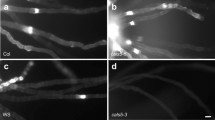Abstract
Pollen tubes are undoubtedly interesting cells. They are unusual in growing by tip-extension, with an ordered zonation of organelles, and are one of the few types of differentiated higher-plant cell that can be grown successfully in single-cell culture. Cultured pollen tubes thus form excellent material for studying the fundamental mechanism of tip-growth (Vasil 1987; Steer áSteer, 1989), the metabolic pathways of individual cells, and cell wall deposition and maturation. The pollen tube is unusual in containing the (1«3)\(\underset{\raise0.3em\hbox{$\smash{\scriptscriptstyle-}$}}{}\)linked glucan, callose, in its walls and septa (plugs) without being wounded, and we are thus using pollen-tube membranes to study the control of callose biosynthesis. Lastly, the pollen tube is the male gametophyte, and in many species bears the receptor for the pistil self-incompatibility (SI) product (Haring et al., 1990); pollen tubes can therefore be used in bioassays for SI (Jackson áLinskens, 1990).
Access this chapter
Tax calculation will be finalised at checkout
Purchases are for personal use only
Preview
Unable to display preview. Download preview PDF.
Similar content being viewed by others
References
Brewbaker JL; Majumder, SK Cultural studies of the pollen population effect and the self-incompatible inhibition. Amer. J. Bot. 48: 457 – 464; 1961
Brewbaker, JL; Kwack, BH The essential role of calcium ion in pollen germination and pollen tube growth. Amer. J. Bot. 50: 859 – 865; 1963
Brewbaker, JL The distribution and phylogenetic significance of binucleate and trinucleate pollen grains in the angiosperms. Amer. J. Bot. 54: 1069 – 1083; 1967
Capkova-Balatkova, V.; Hrabetova, E.; Tupy, J. Effects of cycloheximide on pollen of Nicotiana tabacum in culture. Biochem. Physiol. Pflanzen. 175: 412 – 420; 1980
Cresti, M.; Ciampolini, E.; Pacini, G.; Sarfatti, G.; van Went, JL; Willemse, MTM. Ultrastructural differences between compatible and incompatible pollen tubes in the stylar transmitting tissue of Petunia hybrida. J. Submicr. Cytol. 11: 209 – 219; 1979
Dickinson, DB Rapid starch synthesis associated with increased respiration in germinating lily pollen. Plant Physiol. 43: 1 – 8; 1968
Haring, V.; Gray, JE; McClure, BA; Anderson, MA; Clarke, AE Self-incompatibility: a self-recognition system in plants. Science 250: 937 – 941 (1990)
Herrero, M.; Dickinson, HG Pollen tube growth following compatible and incompatible intraspecific pollinations in Petunia hybrida. Planta 148: 217 – 221; 1980
Herrero, M.; Dickinson, HG Pollen tube development in Petunia hvbrida following compatible and incompatible intraspecific matings. J. Cell Sci. 47: 365 – 383; 1981
Hoekstra, FA; Bruinsma, J. Protein synthesis of binucleate and trinucleate pollen and its relationship to tube emergence and growth. Planta 146: 559 – 566; 1979
Iwanami, Y. Physiological studies of pollen. J. Yokohama Municipal Univ. Series C-34 (Biol. 13) 116: 1 – 134; 1959
Jackson, JF aLinskens, HF Bioassaysfor incompatibility. Sex. Plant Reprod. 3: 207 – 212; 1990
Jahnen, W.; Lush, WM; Clarke, AE Inhibition of in vitro pollen tube growth by isolated S–glycoproteins of Nicotiana alata. Plant Cell 1: 501 – 510; 1989
Kahn, TL; DeMason, DA Citrus pollen tube development in cross-compatible gynoecia, self—incompatible gynoecia, and in vitro. Can. J. Bot. 66: 2527 – 2532; 1988
McClure, BA; Haring, V.; Ebert, PR; Anderson, MA; Simpson, RJ; Sakiyama, F.; Clarke AE Style self—incompatibility gene products of Nicotiana alata are ribonucleases. Nature 342: 955 – 957; 1989
Mulcahy, GB; Mulcahy, DL The two phases of growth of Petunia hvbrida (Hort. Vilm-Andz.) pollen tubes through compatible styles. J. Palynol. 18: 61 – 64; 1982
Mulcahy, GB; Mulcahy, DL The two phases of growth of Petunia hvbrida (Hort. Vilm-Andz.) pollen tubes through compatible styles. J. Palynol. 18: 61 – 64; 1982
de Nettancourt, D.; Devreux, M.; Laneri, U.; Cresti, M.; Pacini, E.; Sarfatti, G. Genetical and ultrastructural aspects of self and cross incompatibility in interspecific hybrids between self-compatible Lycopersicon esculentum and self-incompatible L. peruvianum. Theor. Appl. Genet. 44: 278 – 288; 1974
Read, SM; Rasmussen, R.; Bacic, A.; Clarke, AE Metabolic analysis of cell wall biosynthesis in pollen tubes of Nicotiana alata. Fry, SC; Brett, CT; Reid, JSG, eds. Fifth Cell Wall Meeting, Edinburgh, U.K.; Scottish Cell Wall Group, Edinburgh; 1989; Abst 147
Roggen, HP.; Stanley, RG Autoradiographic studies of pear pollen tube walls. Physiol. Plant. 24: 80 – 84; 1971
Rosen, WG Pollen-pistil interaction in Lilium. Heslop-Harrison, J., ed. Pollen: Development and Physiology; Butterworth, 1971: pp. 239 – 260
Steer, MW.; Steer, JM. Pollen tube tip growth. New Phytol. 111: 323 – 358; 1989
Tupy, J.; Hrabetova, E.; Capkova, V. Amino acids and bivalent cations in the growth of tobacco pollen in mass culture. Plant Sci. Lett. 30: 91 – 98; 1983
Tupy, J; Rihova, L. Changes and growth effect of pH in pollen tube culture. J. Plant Physiol. 115: 1 – 10; 1984
Vasil, IK . Physiology and culture of pollen. Int. Rev. Cytol. 107: 127 – 174; 1987
Editor information
Editors and Affiliations
Rights and permissions
Copyright information
© 1992 Springer-Verlag New York, Inc.
About this paper
Cite this paper
Read, M., Bacic, A., Clarke, A.E. (1992). Pollen Tube Growth in Culture. I. Control of Morphology and Generative Nucleus Division in Cultured Pollen Tubes of Nicotiana . In: Ottaviano, E., Gorla, M.S., Mulcahy, D.L., Mulcahy, G.B. (eds) Angiosperm Pollen and Ovules. Springer, New York, NY. https://doi.org/10.1007/978-1-4612-2958-2_26
Download citation
DOI: https://doi.org/10.1007/978-1-4612-2958-2_26
Publisher Name: Springer, New York, NY
Print ISBN: 978-1-4612-7733-0
Online ISBN: 978-1-4612-2958-2
eBook Packages: Springer Book Archive




